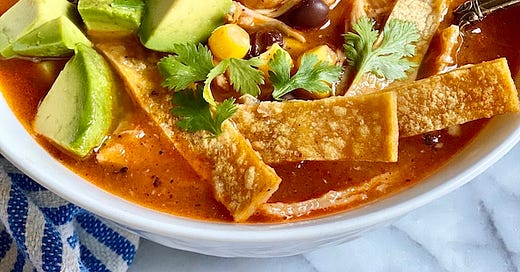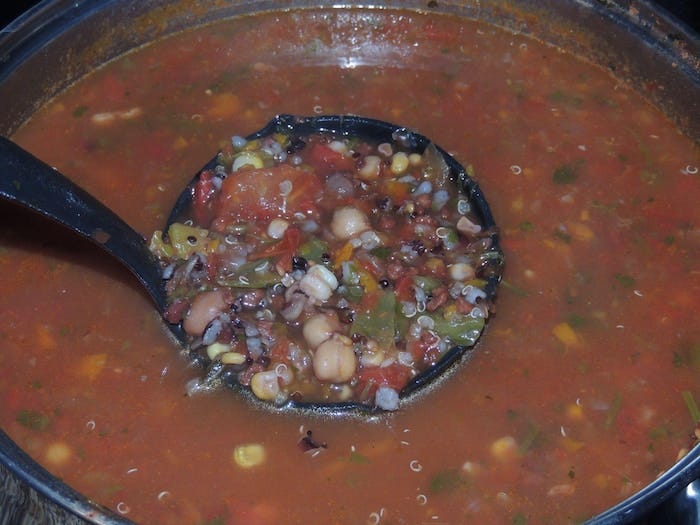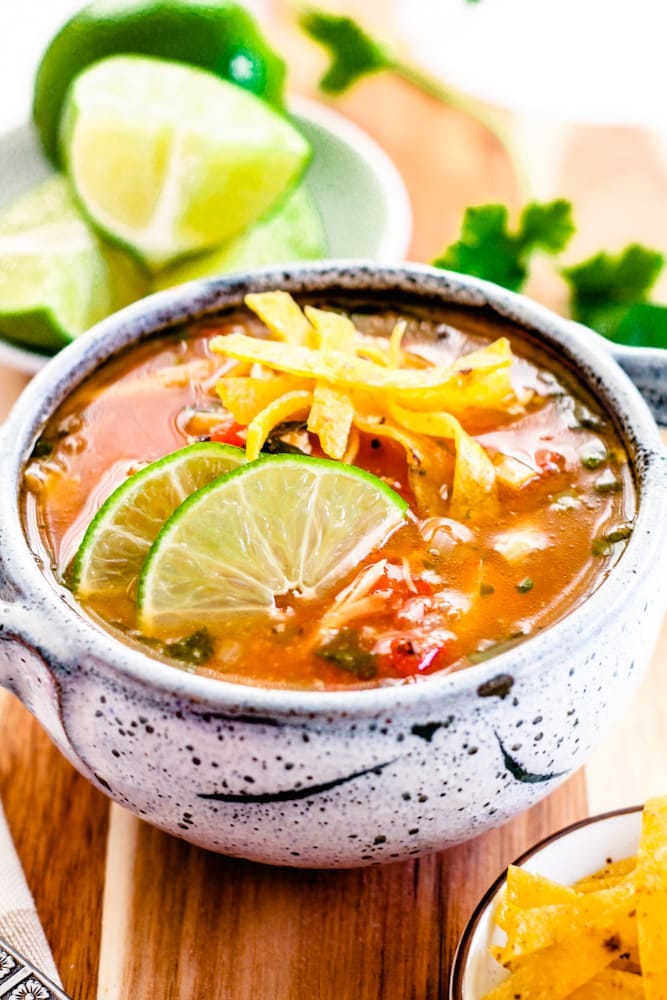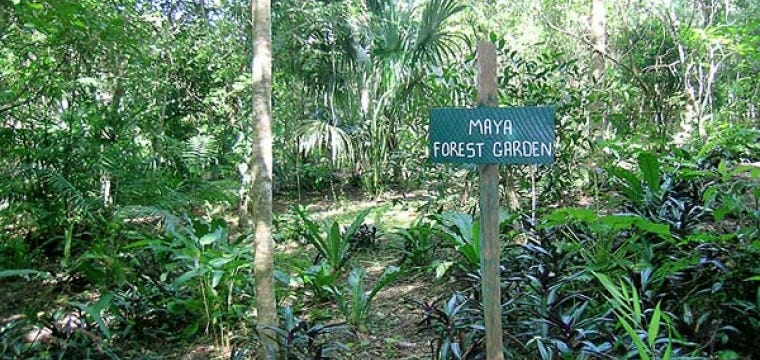Sopa de Lima (Yucatán-Style Lime Tortilla Soup)
This post shares a recipe from my book and some information about the Mayan Milpa crop rotation system, their forest gardens and other soil regeneration techniques developed by indigenous peoples
This sopa de lima, or lime soup, is a Mayan dish originally from Yucatán, Mexico.
The Yucatán Peninsula is home to North America’s largest indigenous population, the Mayans. Stories are told that despite the fact that the Triple Alliance civilization was much more short lived than the Mayan civilization the name for the Yucatán came from the Aztec word “Yokatlān,” meaning “place of richness.”
The rich-sounding name goes hand in hand with this rich-tasting Sopa de Lima.
This is my all-time favorite soup. Below I will share my mom's world-famous lime soup. Some traditional recipes for this soup are minimalistic (basically being a chicken broth with a citrusy background flavor and some light garnishes) but my mom’s adapted version is hearty and vibrant. It's tangy, spicy, it's exuberant and delicious. This one is a crowd-pleaser any day of the week.
Instead of the traditionally used chicken, we like to add beans, wild rice and ancient grains (like Amaranth) for a plant-based protein option. This soup can be made in large batches and freezes well so you can have access to this flavorful and extremely nutritious soup year-round.
Lee`s Tortilla Lime Soup (with a twist)
Ingredients:
- 4 liter of broth (ratio of 2 liters of broth to 1 can of tomatoes)
- 1 large onion
- 2 med-large bell peppers
- 1 bunch of cilantro
- 3 to 4 jalapeno peppers (adding extra hot peppers of different varieties is a fun option too but it does change the soup`s classic flavor profile)
- 1 whole-cooked chicken
- 2 (28oz cans) of whole or diced tomatoes
- 2 to 5 fresh Roma tomatoes (or other homegrown toms)
- 1 ear of corn (we use non-GMO corn)
- 1 to 2 cups cooked rice
- 1 package of corn tortillas (we use non-GMO)
- 1 -2 cups lime juice (depending on tangy-ness preference)
- 1 - 2 ripe avocados
- cheddar cheer (shredded o sprinkle over the soup when served
(Our variation on my mom`s amazing soup substituted beans for the chicken)
- 1 can of black beans, drained and rinsed
- 1 can of Romano beans, drained and rinsed
- 1/2 cup wild rice
- 1 cup diced sweet potato
- diced nettle leaves or goji berry leaves
- 1/2 cup Amaranth seed
Directions:
Make or buy the broth and put it into the largest pot you can find! Seed and devein peppers, then rip them apart and put them aside. Peel and cut the onion into large irregular chunks. Chop the fresh romas into large chunks. Shred the cilantro by hand. In the Cuisinart put the onion, peppers, cilantro and tomatoes, (canned and fresh tomatoes). Pulsate until ingredients are small chunks. In a large pan cook the ingredients that were in the food processor until softened and it reduces in volume a bit (about 10 min on high). Once cooked, add to the broth. Cut the kernels from the cob and add to the pot. (If you can`t find fresh corn you can use 1 cup of frozen corn). Juice limes and really press `em down to get some pulp in there too. Add lime juice (and pulp). Add chicken (or beans). Add rice. If adding wild rice and amaranth, first, fry with some diced onions with oil in a pan (to sear the edges and make for faster cooking times) then add to the soup and bring to a boil briefly (before turning back down to a simmer).
While the soup is simmering, make crispy tortilla strips. (Cut the tortillas into strips no wider than 1 cm and deep fry or pan fry until golden brown).
When serving add some avocado chunks or slices to the bottom of the bowl first, then ladle in the soup and top with cheese and fried tortilla strips, enjoy!
Mayan Milpa gardens and Food Forests
Firstly I think it is worth clearing up any potential confusion regarding what I have found to be a common occurrence with people here in Canada and the U.S. conflating the the Maya with the “Aztec” people of the Triple Alliance. As I explained in my previous post, the Nahuatl speaking people of what is now Central Mexico (commonly referred to as “Aztecs”) lived in central Mexico in the 14th to 16th centuries.
The Maya people on the other hand lived (and continue to live) in southern Mexico and northern Central America — a wide territory that includes the entire Yucatán Peninsula — from as early as 2600 BC (some accounts and archeological data points indicating their civilization dates back 8000 years+). Conventional historical accounts date the Mayan civilization’s height between 250 and 900 AD.
Mayan languages are spoken by at least 6 million indigenous Maya, primarily in Guatemala, Mexico, Belize and Honduras. In 1996, Guatemala formally recognized 21 Mayan languages by name.
Evidently, the Mayan people must have developed very effective methods of cultivating food to be able to sustain their civilization for that long while remaining in the same region, but what did that food cultivation system look like?
Enter the The Milpa Forest to Garden to Forest Cycle.
The milpa cycle is the conservation method of farming and managing the Maya forest. It goes through four main stages over the course of approximately 20 years: from the forest to the milpa; from the milpa to the forest garden; and from the forest garden back to the forest.
The traditional milpa and forest garden is an unplowed, multi-crop field that sustains biodiversity and animal habitat while producing plants for food, spice, shelter, medicine, ornament and excess crops, materials and medicines to be traded and/or sold. It can be fertilized by household refuse (compost), organic material (dead weeds), ashes from carefully managed fires, and manure, enriching the soil and increasing productivity without the use of chemically manufactured fertilizer.
For over 8,000 years, the Maya forest gardeners have been sustaining and cultivating the Maya Forest with their Indigenous scientific practices.
This highly productive, sustainable and potentially regenerative system of food cultivation, construction material production, medicine cultivation and animal habitat conservation formed the foundation for the development of the Mayan cities, existing as a stable civilization in symbiosis with the ecosystem that supported it from 3,000 to 1,000 years ago, and was intensified during the latter millennia of a stable climatic regime as population grew and the civilization developed. These strategies of living in the forest evolved into the milpa cycle—the axis of the Maya Forest garden resource management system that created the extraordinary value recognized in the Maya Forest today.
The milpa cycle transforms in stages, and grows back into a closed canopy forest at the end. At least two-thirds of the milpa is part of the forest at any point of the Milpa cycle to conserve the Maya Forest. Maya forest gardeners traditionally have more than one milpa each at different stages cycling at the same time to maximize the multifunctionality of the landscape and crop rotation that ensures diversity in product yields.
An imperialist colonial view depicted the coppice-and-burn aspect of the milpa cycle as a barbaric practice that destroys the ecosystem. Coppice-and-burn was perceived as a single action, not a carefully monitored multi-step process that advances forest growth. The same hubristic and short sighted view of indigenous agroforestry and controlled burn techniques that served to facilitate a symbiotic relationship between the people of the Plains and the Buffalo further north was adopted by the Europeans that invaded what is now Canada and the United States.
Botanists, agroecologists, and ecological restorationists now recognize the importance of this method for sustainable agroforestry and managing local biodiversity.
There is another data point worth mentioning here that illuminates the fallacy of the colonial imperialist propaganda that depicted the Mayans and other indigenous peoples as “primitive”, “uncivilized” and/or “savages” and that is how researchers have uncovered a 2,000-Year-Old Maya water filtration system which utilized methods that exemplify an advanced scientific understanding.
More than 2,000 years ago, the Maya built a complex water filtration system out of materials collected miles away. Now, reports Michelle Starr for Science Alert, researchers conducting excavations at the ancient city of Tikal in northern Guatemala have discovered traces of this millennia-old engineering marvel.
As detailed in the journal Scientific Reports, the study’s authors found that the Maya built the Corriental reservoir filtration system as early as 2,185 years ago, not long after settlement of Tikal began around 300 B.C.
The system—which relied on crystalline quartz and zeolite, to create what the researchers call a “molecular sieve” capable of removing harmful microbes, heavy metals and other pollutants—remained in use until the city’s abandonment in between the years of 900 - 1100. Today, the same minerals are used in modern water filtration systems.
Another misconception about Mayan traditions (in this case specific to their food forest cultivation techniques) arises from the fact that modern western mechanized cultivation systems, in an effort to produce large yields for maximizing profits, have centered on plowing believing the deep soil were needed for healthy agricultural fields. Thus, they considered rocky soil undesirable and assumed that the ‘primitive’ Maya cultivation system could not support large populations without destroying the shallow tropical soils. This view fails to appreciate the productive potential of the rocky soils when managed with traditional forest gardening methods. Practices like letting organic material accumulate can increase soil fertility and friability to invite new plant growth.
Unlike the mono-crop trend of Western agriculture, plants are intentionally grown around the corn in the poly-culture milpa cycle. Underneath growing corn can lie 30 different plant species and close to 100 annual plants. Some are used as pest attractors to redirect the insect from edible growth, while the breaking of the corn stock channels waters to the growth below when it rains. Similar to other plants that are considered “weeds”, the Maya invite these necessary plants to avoid utilizing damaging pesticides.
Since (as mentioned above) at any given time in the milpa cycling process at least 2/3 of an area being managed by a traditional Mayan farmer is forest, despite the coppicing and burning aspect of the cycle, biodiversity, soil stabilization and animal habitat is maintained steadily throughout the entire cycle.
The result of opening up sections of the canopy of the jungle through coppicing and burning and then encouraging diverse native species to regenerate from the neighboring full canopy jungle (selecting for edible ad medicine plants to become dominant in the regenerating forest means setting up long term self perpetuating food forests that can feed many future generations.
The indigenous peoples of the Amazon rainforest also used coppicing, controlled burns, composting and Biochar to create some of the most abundant and productive food forests which are supported by some of the most fertile living soils on Earth (called “Terra Preta”).
Terra Preta, meaning "Black Earth" in Portuguese, is a soil building technique developed by ancient Amazonian civilizations at least 7000 years ago as a solution to permanently solve the problems of poor tropical soil fertility. Large deposits of this black earth are still found today with depths of up to 2 meters. The first deposits where discovered in 1870, but it has only been in the last 10 years that significant interest and study have been initiated.
This soil is attributed to the complex civilizations that once thrived in the Amazon. Prior to the onset of diseases brought on by the western settlers, this expansive web of communities is estimated to have totaled over 100 million people. The Terra Preta soils are what sustained them in harmony with their ecosystems.
Terra Preta is of prehistoric origin and is higher in nitrogen, phosphorus, potassium and calcium than adjacent soils. It controls water and reduces leaching of nutrients from the rhizosphere. Rich in humus, pieces of pre-Columbian unfired clay pottery, and black carbon, it’s like a “microbial reef” that promotes and sustains the growth of mycorrhizae and other beneficial microbes, and it has been shown to retain its fertility for thousands of years. In university trials, terra preta has increased crop yields by as much as 800 percent. It regrows itself when excavated (due to the beneficial microbes).
The Potawatomi people who called the land where I now live (around the Great Lakes of what is now called “Canada”) also used a similar technique to the Maya’s Milpa for opening up sections of the Carolinian forest canopy and using controlled burns to allow for cultivation of sun loving companion planted annuals, while enriching the soil and setting the stage for long term food forest design.
Given many of us now live in areas where we have no trouble getting enough sunlight for annual sun loving crops and given how we need to protect all the old growth trees we have left, perhaps we can skip the forest clearing aspect, but combine other aspects of the Milpa techniques with techniques for creating Terra Preta to create pockets of deep, beautiful, dark soil that can become the foundation for many years of gardening and building food forests.
There are many ways we can learn from and adapt the milpa garden cycle and food forest development cycle that can be applied without requiring a “slash and burn” or “coppice and burn” component to the process (given many of us live in areas that have been almost completely deforested already). We can use controlled burns (Biochar generation) of brush and dead woody debris that we have available from windfalls/pruning to help jump start the regeneration and begin the process of creating Mayan style food forests by identifying choice edible, medicinal, functional and habitat providing native species in out region, propagating them and building a food forest from the ground up.
Perhaps some day, a generation or two (or 7) down the road, if our forests begin to become so abundant that we find ourselves needing some space and light for our favorite annual food and medicine plants, we can re-visit applying the full milpa technique again where we live.
One great place to start down the path of combining the best of the knowledge that ancient cultures like the Mayans, the indigenous people of the Amazon and Turtle Island with regards to nourishing soil and creating a foundation for abundant long term food forests is by learning how to create out own living soil by scaling up beneficial indigenous soil microorganisms, through composting and working with other beneficial microbe consortiums that are present in worm castings and products like EM1 (aka “effective microorganisms”) and then making our own Biochar (which provides those beneficial microbes a long term substance to set up a permanent and prominent presence in your soil).
Here are a couple videos by a couple friend’s of mine that explain what living (or “regenerative”) soil and Biochar is and how one can make it at home.
For more information on Mayan food cultivation and water filtration methods as well as additional info on annual polyculture farming and or food forest development that involved so called “slash and burn” cycling techniques:
https://underwoodgardens.com/terra-preta-magic-soil-of-the-lost-amazon/
https://www.edhat.com/news/heroes-of-the-maya-forest-humanist-society
https://web.archive.org/web/20121231153714/https://www.espmaya.org/milpa.html
https://umassdining.com/blog/permaculture/mayan-forest-gardens-1
https://valhallamovement.com/ancient-maya-used-food-forest-permaculture-to-feed-their-population/
I would like to make it clear that (as with the post I shared previously that offers information about the Chinampa floating gardens of the Triple Alliance) I am not saying the Mayan people were perfect or that we should emulate them in all ways (that is true of all ancient cultures). I feel we can acknowledge how certain practices of ancient cultures were regenerative, ingenious and aligned with integrity while other practices were not (learning from the regenerative practices, honing them using modern methods and discarding the rest). I am sharing the above info because I advocate for doing what is suggested in The Seventh Fire Prophecy (which involves consciously learning from the wisdom of those that came before as so that we can choose a greener, more abundant, more honorable and more regenerative path in the future). In the spirit of gleaning wisdom from those that came before us to improve the way we produce food and interact with the more than human world I think it is worth exploring the potential for applying the most regenerative aspects of the milpa food forest crop rotation growing system in colder climates (so that those of us who live in the temperate can adapt and learn to cultivate food in a more regenerative way.
If you liked the content above you may want to check out my book (Recipes For Reciprocity: The Regenerative Way From Seed To Table) which was just released in eBook format.
When you cultivate food in the garden in a way that gives back to the living Earth and honors the many gifts we have been given in this life (including learning from cultural wisdom from those that came before us) you are engaging in the sacred act of Reciprocity.
Using your hands to give back to the Earth and to give thanks to Creator for the gift you have been given in this human body, by taking good care of it with nourishing, delicious and vibrant meals (that use food as medicine and provide poetry for the soul) is a way to give back to your body, your temple and thus a way to give back and say thank you to Creator.
One of the most powerful choices we can make to heal the relationship to Mother Earth, give back to and honor our sacred temple and in doing so engage in an act of Reciprocity begins with a handful of seeds and some TLC.
I am wishing you all a spring time filled with hope, peace, feeling nourished and inspired by the abundance you cultivate and create in the garden and in the kitchen.











Wow, YUM.
I grew up in San Antonio, and visited Mexico several times... I LOOOOVE the food.
I love Tortilla Soup, and soup, generally.
Can't wait to try this! GRACIAS!!
I'm in great anticipation of your book becoming available in a print version.